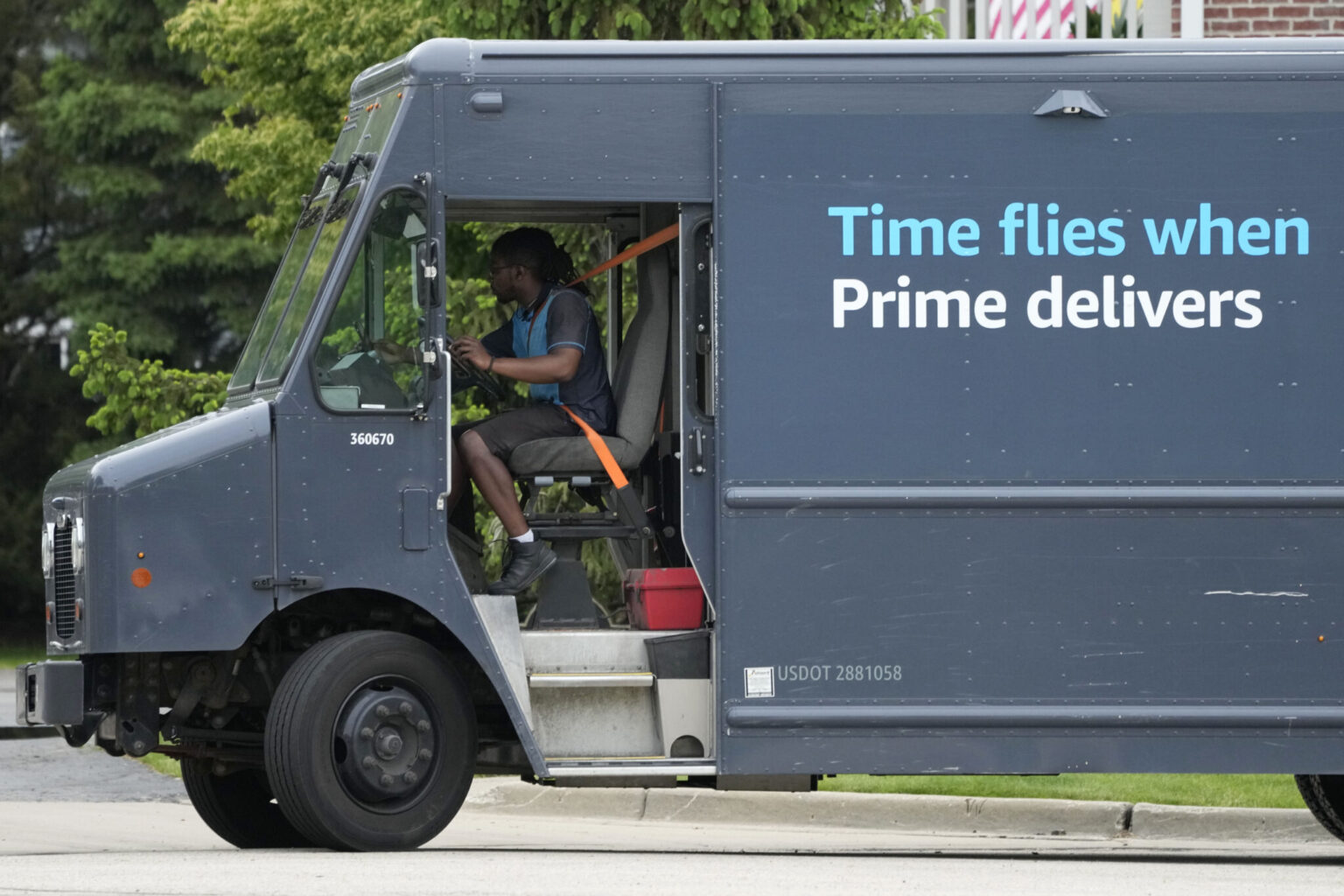10:23
News Story
For decades, states have relied on gas taxes to provide much of the money to maintain roads and bridges. But as cars become more fuel efficient, and some Americans switch to electric vehicles, state leaders say the gas tax won’t pay the bills for much longer.
At the same time, many cities have seen their streets crowded with delivery trucks from Amazon and other companies, as consumers increasingly opt to have products delivered to their homes. In a few states, lawmakers think fees on those deliveries could be part of their road-funding solution.
“If you’re going to be creating wear and tear on our roads, you should help pay to maintain them,” said Colorado state Rep. Cathy Kipp, a Democrat who chairs the Energy and Environment Committee.
In July 2022, Colorado became the first state with a retail delivery fee, a charge on all vehicle deliveries to consumers within the state. The fee, which currently stands at 29 cents per delivery, provides funding for highways, bridges, tunnels, electric vehicle charging stations and projects to reduce air pollution and to electrify vehicle fleets and transit systems. It has brought in more than $160 million.
Colorado leaders have had to simplify the law to help businesses comply with it, but they say it’s largely been a success story. Minnesota enacted its own retail delivery fee in 2023, and lawmakers in New York and Illinois have proposed similar measures. Meanwhile, legislators and transportation officials in several other states have commissioned studies to consider the concept.
Some retailers and Republican lawmakers have argued that the fee hurts consumers, and many businesses in Colorado initially had trouble complying with the law.
“The 27-cent delivery fee is not trivial, its effects are not imperceptible, and it greatly affects our citizens — especially those who are already struggling to pay the bills and provide for their families,” Republican state Rep. Rose Pugliese, the House minority leader, wrote in a Colorado Springs Gazette guest column several months after the law was enacted.
But backers of the fee say they see growing interest across the country, especially as delivery trucks become ubiquitous in many neighborhoods.
‘Future-proofing’ transportation funding
State law in Colorado limits the ways in which lawmakers can expand taxes. With gas tax revenues dwindling, legislators didn’t have an obvious solution to pay for roads. They eventually settled on the retail delivery fee, which is not characterized as a tax.
Initially, the program was a struggle for many businesses, due to a requirement that they detail the fee separately on each receipt.
“For our medium and small businesses, it was a real complicated thing and very burdensome for them to have to reprogram their software with a whole extra line item,” Kipp said.
Last year, Kipp joined a bipartisan group of lawmakers to amend the program. They rescinded the requirement that businesses itemize the fee on each receipt and allowed companies to cover the fee themselves rather than breaking it out on each order. They also exempted retailers with less than $500,000 in sales.
Since the fix was adopted, Kipp said she has stopped hearing complaints about the program. Chris Howes, president of the Colorado Retail Council, said he too has not heard any recent gripes.
“We’ve got it straightened out by now,” he said. “People have accepted it and moved on.”
Amazon did not grant a Stateline interview request, and the National Retail Federation deferred questions to state chapters. Chamber of Progress, a tech industry advocacy group, did not arrange an interview by publication time.
Last year, lawmakers in Minnesota enacted their own retail delivery fee, a 50-cent charge on purchases of more than $100. Lawmakers heard from local governments that they were struggling to maintain their roads and badly needed state aid to make up the gap.
“This is trying to future-proof our transportation funding,” said Democratic state Rep. Erin Koegel, who sponsored the bill. “We keep getting performance grades from civil engineers saying we’re at a C- or D for our infrastructure. We needed to think about ways to get more revenue in the system.”
Koegel said the measure was a compromise. Her initial draft, which did not have a $100 threshold for purchases, was intended to be a deterrent, much like cigarette taxes. She said delivery trucks are increasing congestion in many cities and damaging streets that weren’t built to support large vehicles. However, lawmakers ultimately decided to limit the fee to more expensive purchases in order to protect lower-income consumers.
Minnesota’s fee is projected to generate $59 million in its first fiscal year. The funding will be distributed to cities, counties and towns to help with their road-funding needs.
Traffic throughout the day
Cities and counties in Washington state also have asked for help, and some local leaders have asked state lawmakers to consider a retail delivery fee — or to authorize cities to collect one. State lawmakers commissioned an analysis, published last month, looking at the potential for such a program. The report found that a fee could generate $45 million to $112 million in revenue in 2026, depending on which businesses and orders were covered.
“We’re now seeing that there’s traffic on our system throughout the day, and the growth of these delivery services is a part of that,” said Democratic state Sen. Marko Liias, who chairs the Transportation Committee. “We’ve had a history in transportation of user-based fees. This feels like a mechanism that could help in that regard.”
Liias emphasized that some version of the fee is likely to be a big topic of discussion in the next legislative session. He said he’s already heard strong arguments on both sides of the issue.
In some areas, the rise in retail deliveries has put the greatest burden on the infrastructure surrounding shipping facilities. Illinois’ CenterPoint Intermodal Center, the nation’s largest inland port, connects interstate trucking, railway lines and Mississippi River barges.
“There really needs to be a shift in the tax structure, since many of these facilities are not generating the local sales tax you’d get at a brick and mortar,” said Democratic state Sen. Rachel Ventura, whose district includes the CenterPoint facility. “We have a lot of traffic going in and out, and the environmental burden and road repairs and the tax burden fall locally.”
Ventura has drafted a bill that would allow communities to assess fees on intermodal facilities — locations that transfer products from one type of transportation to another. Local governments that opted in would be able to spend the funds on roads within five miles of the facilities. The fee, which would be based on the weight of each shipment, is projected to generate $33 million to $68 million per year.
The bill has not passed out of committee, and Ventura said lawmakers are still discussing the path forward amid opposition from the trucking industry.
In New York, a Democratic bill to impose a 25-cent fee on deliveries within New York City has been introduced but remains in committee. Meanwhile, state agencies in Nevada and Ohio have commissioned studies examining the feasibility of retail delivery fees. Those reports have not yet led to legislative action.
Stateline is part of States Newsroom, a nonprofit news network supported by grants and a coalition of donors as a 501c(3) public charity. Stateline maintains editorial independence. Contact Editor Scott S. Greenberger for questions: [email protected]. Follow Stateline on Facebook and X.
Our stories may be republished online or in print under Creative Commons license CC BY-NC-ND 4.0. We ask that you edit only for style or to shorten, provide proper attribution and link to our website. AP and Getty images may not be republished. Please see our republishing guidelines for use of any other photos and graphics.





